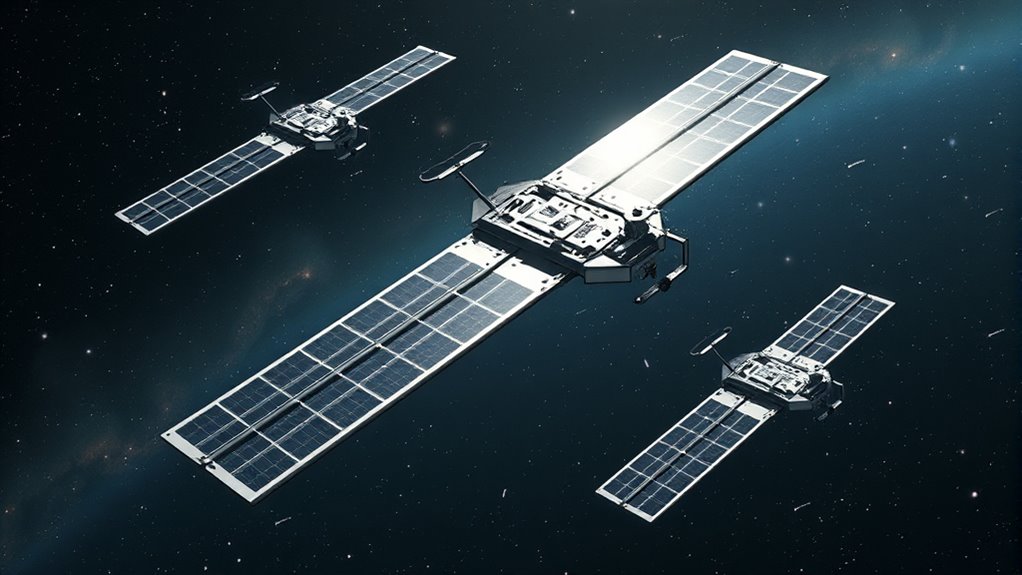You see, the National Reconnaissance Office (NRO) operates a fleet of sophisticated satellites that serve as invisible spies in space. These satellites gather high-resolution images and intercept signals, helping your nation monitor military movements, infrastructure, and environmental changes worldwide. They work silently from orbit, providing real-time intelligence without revealing their presence. If you want to uncover how these space-based eyes keep your country secure and what secrets they might hold, there’s more to discover beyond the surface.
Key Takeaways
- The NRO operates advanced satellites that serve as “spies in space,” collecting intelligence for national security purposes.
- These satellites utilize optical and radar sensors to capture high-resolution images and monitor ground activities regardless of weather or time.
- The NRO’s satellite fleet also intercepts electronic signals, enhancing signals intelligence capabilities.
- Space-based surveillance provides continuous, real-time intelligence, influencing military decisions and foreign policy.
- The operation of these silent satellites extends espionage capabilities beyond traditional human spies, ensuring strategic advantages.

Have you ever wondered if nations are secretly monitoring each other from space? It’s a fascinating thought, but it’s also very real. Behind the scenes, governments deploy sophisticated satellite technology to keep tabs on global activities, guaranteeing national security and strategic advantage. These satellites serve as the eyes in the sky, collecting intelligence data that would be impossible to gather through traditional means. When you think about intelligence gathering, you’re imagining high-tech tools silently orbiting above, providing critical information without anyone knowing. This is precisely what the National Reconnaissance Office (NRO) specializes in. They operate a fleet of advanced satellites designed specifically for surveillance, reconnaissance, and intelligence gathering.
Governments use stealthy satellites to secretly monitor the world and safeguard national security from space.
The NRO’s satellite technology is among the most secretive and powerful in the world. These satellites can capture high-resolution imagery, intercept signals, and monitor movements across vast areas. Whether it’s tracking military activity, observing infrastructure developments, or evaluating environmental changes, the NRO’s satellites are essential to national security. They work around the clock, relaying data back to analysts who interpret what’s happening on the ground. This constant flow of information allows decision-makers to respond swiftly and accurately to emerging threats or opportunities. You might think of these satellites as the ultimate spies—hidden, swift, and precise.
What makes the NRO’s satellite fleet so impressive is its diversity. Some satellites are equipped with optical sensors that produce detailed images comparable to aerial photography, while others use radar technology to see through clouds and darkness. These capabilities guarantee that intelligence gathering doesn’t stop, regardless of weather conditions or time of day. Additionally, signals intelligence satellites intercept electronic communications, providing insights into potential threats or diplomatic developments. This layered approach makes their surveillance extensive and difficult to counter. Satellite technology extends the reach of human spies into space, making their operations more effective and resilient.
Ultimately, the NRO’s satellite technology exemplifies the intersection of cutting-edge science and strategic intelligence. It’s like having a network of invisible eyes watching over the world, collecting vital data without ever revealing their presence. The intelligence gathered from these satellites influences military decisions, foreign policy, and even disaster response. For you, understanding the scope of such operations reveals just how deeply space has become a domain for espionage. It’s a silent, constant watch that keeps nations safe and prepared, all thanks to the incredible capabilities of satellite technology and the silent sentinels orbiting above.
Frequently Asked Questions
How Many Satellites Does the NRO Currently Operate?
You’re likely curious about the current number of satellites the NRO operates. Right now, it’s estimated that the NRO manages over 100 satellites, involved in satellite deployment to monitor various global activities. These satellites are strategically positioned based on orbital dynamics to maximize coverage and intelligence gathering. Their deployment guarantees robust surveillance capabilities, helping national security agencies stay ahead in a complex, ever-changing space environment.
What Is the Lifespan of a Typical Reconnaissance Satellite?
You might think all satellites last forever, but the truth is, their satellite lifespan varies. Typically, reconnaissance satellites have an operational longevity of 5 to 15 years, depending on their technology and mission needs. Some are built for quick deployment and shorter missions, while others are designed to stay in the sky longer. So, you should keep in mind that even high-tech satellites face wear and tear over time.
How Does the NRO Ensure Satellite Security From Cyber Threats?
You can trust that the NRO secures its satellites by implementing robust cybersecurity protocols and advanced encryption techniques. They constantly monitor for cyber threats, patch vulnerabilities promptly, and use layered defenses to protect sensitive data. You should know that these measures make it difficult for unauthorized access or cyber attacks to succeed, ensuring the satellites’ integrity and the security of the intelligence they gather.
Are NRO Satellites Capable of Real-Time Data Transmission?
Yes, NRO satellites are capable of real-time data transmission. They utilize advanced satellite encryption to protect sensitive information during transmission. Their data relay systems enable quick transfer of intelligence, ensuring you get timely updates. This combination of encryption and data relay makes real-time communication secure and efficient, allowing you to access critical intelligence swiftly while maintaining high security standards.
What Advancements Are Being Made in Satellite Stealth Technology?
Imagine you’re in the year 3024, and satellite stealth tech is cutting-edge. You’ll see advancements like advanced stealth coatings that absorb radar waves and materials designed for radar evasion, making satellites nearly invisible to enemy sensors. These innovations help satellites operate undetected, enhancing national security. Researchers continually refine these methods, combining new materials and innovative designs, ensuring satellites stay one step ahead of detection, even as technology evolves beyond our current understanding.
Conclusion
You now see how the National Reconnaissance Office’s satellite fleet works like a silent orchestra, constantly watching over us from space. These spies in space gather essential intelligence that shapes national security, all while remaining invisible and discreet. Just as a lighthouse guides ships safely through dark waters, their satellites provide critical guidance and protection. Remember, behind the scenes of space, these unseen guardians play a key role in keeping us safe every day.









